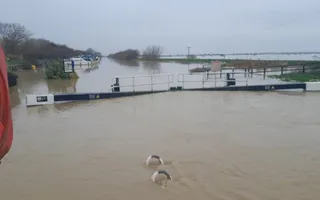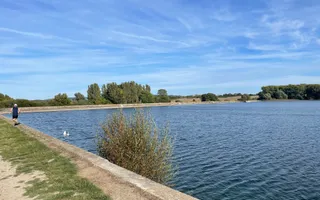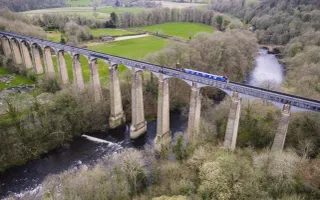Welcome to the first edition of the year (Happy New Year if it's not too late!).
Boaters' Update 17 Jan 2025
Latest work to keep navigations open, important safety alert, recycling update and more in latest edition.

In this edition you'll find:
- Working for boaters – winter break spent tackling weather related issues
- Chief executive speaks to national press about the importance of canals
- Working for boaters – up north
- Working for boaters – in numbers
- Protecting water for boaters
- Maintenance, repair and restoration work this weekend
- ‘Simpler Recycling’ in England
- Important safety alert for users of Morco LPG water heaters
Working for boaters – winter break spent tackling weather related issues
While many of us were overindulging, the weather took no such downtime over the festive period with our on-call teams responding timely to many issues around the network.
Geographically speaking, there was damage from the weather in just about every part of the network. However, the biggest disruption to our waterways was caused in the north and east.
As an indicator of the extreme amount of rain received, Slaithwaite Reservoir, which feeds the Huddersfield Narrow Canal, spilled – when a reservoir reaches capacity it runs off water, or ‘spills’, into a nearby watercourse – for the first time in four years. The severe weather on this part of the network also led to drenched embankments failing at Lock 11.
Out on the Leeds & Liverpool and Stainforth & Keadby canals our teams were out on the network ‘running’ water to bring levels down. Further south and east, on the Leicester Line at Loughborough and the River Trent, teams were doing the same to reduce the impact of the massive influx of water.
Over 200 houses flooded in the local area along with over 50 roads closed due to flooding. A multi-agency major incident was declared with our engineers and local teams working around the clock to divert as much water as possible away from the affected areas.
Of course, the initial downpours are just part of the story. For example, on the Ripon Canal, once the floodwater started to recede, the water levels just kept dropping. On investigation, debris washed down by the floodwater had blocked a feeder and was soon resolved. In other areas, with unstable waterlogged ground, we also had scores of trees come down.



Washed out towpath on the Huddersfield Narrow Canal
Chief executive speaks to national press about the importance of canals
The article above, along with previous coverage of storm damage in the last two Boaters’ Update of 2024, demonstrate that extreme weather events, brought on by climate change, are increasingly common and increasingly damaging. It also shouldn’t go unmentioned that global average temperatures for 2024 were around 1.6C above those of the pre-industrial period – the first time it’s breached the 1.5C barrier.
As reported by The Guardian, chief executive Richard Parry, says that protecting the UK’s navigable canals is crucial for improving the nation’s resilience to climate change.
Our Impact Report, published just before Christmas, found that the canals we boat upon and enjoy and that support tourism can also play a “critical role” in biodiversity, decarbonisation and climate adaptation.
The network provides the longest corridor of freshwater habitats in the UK, which are a vital home within cities for a variety of wildlife. Acting as a “nature highway”, canals allow species to thrive and move safely between cities and the countryside.
Richard also said canals could also help reduce the impacts of extreme weather on urban communities. During periods of heavy rainfall, for example, canals can act as drainage routes and mitigate the impact of increasingly extreme weather events:
“They’re such an integral part of so many of our towns and cities, having been built more than 200 years ago, their whole purpose changing so dramatically over time. They are now cherished by thousands of boaters and are also highly valued local spaces for people to get close to nature, as well as water security and flood mitigation.”
As the UK faces an increased risk of summer droughts, canals could provide water security to densely populated areas. The network currently supplies drinking water to more than five million people, transferring water to parts of Cheshire via the Llangollen Canal, and to Bristol through the Gloucester & Sharpness Canal.
Waterways could also help keep Britain’s cities cool, as the Impact Report explains – during the 2022 heatwaves, urban canals reduced surrounding temperatures by an average of 2C in Manchester, Birmingham and London.
Once used to transport coal, canals are quickly becoming their own renewable energy source. A district heating network in Liverpool is due to open in the coming months, using water from the Leeds & Liverpool Canal to supply heat to more than 9,000 homes and four million sq/ft of commercial spaces.
Climate breakdown brings its own challenges for the future of canals, many of which are more than 200 years old. This was dramatically demonstrated earlier this month when heavy rainfall led to a breach of the 18th-century Bridgewater Canal in Cheshire (for clarity, this isn’t part of our network but managed by Peel Holdings). In 2023 alone, eight storms battered our network, causing £10m of damage.
Richard continues: “They’re miracles of their day – there was no template for canals or reservoirs. The engineering skill with which they were built is amazing. However, the original materials used – clay, stoneware and concrete – are prone to rapid erosion during extreme weather events and frequently need maintenance. We’ve got to make them more resilient.
“Having got through the last 250 years, canals are adding benefit to our lives in ways that we would never have anticipated before. It’s so vital that we are able to sustain that for future generations.”

Working for boaters – up north
While bearing the brunt of the recent extreme weather, Yorkshire & North East regional director Sean McGinley wrote in the Yorkshire Post about our current ‘Perfect Storm’ campaign alongside the work that we’re doing over the next few months to keep them safe and navigable:
“Yorkshire is blessed with a rich system of canals, and it’s incredible to think that this amazing 250-year-old network is busier nowadays than at the height of the Industrial Revolution, with more boats using it and millions walking and cycling on the towpaths.
“Yorkshire’s 320-mile canal network shapes much of our region, with not only the waterways winding their way through our villages, towns and cities, but also the many bridges, embankments, aqueducts and locks that are iconic landmarks.
“An innovative feat of engineering in its time and still awe-inspiring, notwithstanding it being used by thousands of boaters, it’s in essence a free-to-visit, outdoors, working museum – a national treasure. And canals still have a valuable role to play in society today, from those who cruise or live on them through to bringing nature, vital green space and traffic-free routes to millions of people in many of our most urban areas.
“However, a ‘perfect storm’ is threatening the very future of our fragile canal network. We need to constantly maintain and repair these ageing waterways and their structures which, combined with climate change and shrinking government support, poses many challenges.
“But it’s not all doom and gloom; our charity is striving to overcome these odds and we’re acting now to keep our canals open and alive. We’ve launched our first fundraising campaign to raise much needed support in the face of the rising cost of repairing storm and flood damage.
“Last winter alone, a succession of ‘named’ storms amounted to £10 million of additional and unforeseen repairs to waterways across the country. This is not a negligible sum for our charity to find when our funding is already stretched and, this winter, we’ve already seen several storms cause more costly damage.
Working for boaters
“And all of this is in addition to our annual planned winter works programme of heritage and conservation maintenance tasks which is now underway across Yorkshire. Over the next few months, new lock gates, handcrafted in our specialist workshop in Stanley Ferry, Wakefield, are being installed, while other work includes masonry repairs to centuries-old bridges and tunnels, work to fix leaks and preserve water for navigation, and inspections of important ageing infrastructure.
“On the Leeds & Liverpool Canal, at Bank Newton, near Gargrave, lock gates are being replaced and repairs made to lock chambers, quoins and cills. Leeds Lock 1 behind Leeds railway station has also been drained for essential work to be undertaken. Vital repairs are also being made to Cowling Swing Bridge, while Booth’s Swing Bridge, near Keighley, has been repaired and is open again. Elsewhere in Yorkshire, there will be lock gate replacements and repairs along the Huddersfield Narrow Canal, Aire & Calder Navigation, South Yorkshire Navigation and Chesterfield Canal.”

Working for boaters – in numbers
With over 2,000 miles of canals and rivers it’s nigh on impossible to list all the things we’ve been doing over the last fortnight to keep navigations open (I’m sure you haven’t got a spare couple of days to read the entire list!) but a scan of our stoppage notifications shows that we’ve…
| Description | In the last fortnight | Since we started reporting (12 July 2024) |
| Removed wind-blown trees that were impeding navigation | 18 | 162 |
| Lock gate replacement | 14 | 15 |
| Conducted/facilitated bridge inspections | 12 | 159 |
| Fixed (or in the process of fixing) embankments | 12 | 30 |
| Carried out general lock repairs such as repairing quoins and brickwork | 11 | 103 |
| Repaired bridges | 5 | 56 |
| Repaired culverts | 3 | 12 |
| Carried out boater safety activities (such as placing buoys around hazards etc.) | 2 | 15 |
| Carried out dive survey/repair | 1 | 23 |
| Pollution incident | 1 | 3 |
The above list doesn’t include any work conducted purely on towpaths, water management (which there’s always a lot of!), major reservoir projects and so on – it’s just a flavour of what we’ve been doing to help boaters keep moving on the cut!
Protecting water for boaters
Over the past couple of years you’ll have read about multiple projects at our vital network of reservoirs. We’re continuing to spend around £20 million per year to make sure they comply with the strict legislation that applies to all large reservoirs.
As part of this we’re planning a 15-month programme of statutory works to strengthen the embankments at Wilstone Reservoir, near Tring in Hertfordshire. Stretching for 1,350 metres, the embankments at Wilstone Reservoir are one of the longest of the 71 major reservoirs in our care.
The project, estimated to cost £6 million, has started this week with site preparations. Work to install two thousand 11-metre-long steel sheet piles into the reservoir’s two 200-year old embankments, will begin in May.
Wilstone Reservoir is part of the Tring Reservoirs Nature Reserve, a Site of Special Scientific Interest (SSSI). Built to supply water to the Grand Union Canal, the reservoirs are now also one of the best birdwatching spots in southern England. The four individual reservoirs in the Tring Reservoirs Nature Reserve are Startop’s End, Marsworth, Tringford and Wilstone.
Wilstone is the largest of the four reservoirs at 119 acres (48 hectares). It is up to 18 feet (5.5 metres) deep and has the capacity to hold over one million mega litres of water, the equivalent of over 300,000 Olympic sized swimming pools. The reservoir has two five-metre wide embankments stretching for a total of 1,350 metres and ranging in height from two to eight metres.
Ros Daniels, London & South East director, explains: “Wilstone Reservoir provides an important place for water storage to support navigation on the Grand Union Canal and has also become a popular site for angling, walking and bird watching.
“This winter we’ll begin a programme of essential maintenance work to strengthen the reservoir’s embankments, securing it for the future. These are statutory safety works required under the Reservoir Act.
“To minimise disruption to boaters, the reservoir won’t be drained during the works, but the water level will be lowered by 0.5 metres below capacity. The reservoir will continue to supply water to the canal, and the water level in the reservoir will slowly reduce throughout the summer, as usual. Our engineering project team will use land-based equipment to carry out the works and, to minimise the ongoing impact of the work, will include a silent piling machine.”

Maintenance, repair and restoration work this weekend
As you’ll know there are times when we need to fix things that unexpectedly break. Of course, you’ll notice that the list below is much longer now that we’re in the winter stoppage season! So, below, you’ll find a list of navigations that have ongoing restrictions that may affect you if you’re planning to get out on the water this weekend:
- Aire & Calder Navigation
- Bridgwater & Taunton Canal
- Calder & Hebble Navigation
- Chesterfield Canal
- Dudley No 2 Canal
- Fossdyke Canal
- Grand Union Canal
- Huddersfield Broad Canal
- Huddersfield Narrow Canal
- Kennet & Avon Canal
- Lancaster Canal
- Leeds & Liverpool Canal
- Llangollen Canal
- Macclesfield Canal
- Monmouthshire & Brecon Canal
- New Junction Canal
- Old Main Line
- Oxford Canal
- Peak Forest Canal
- Ribble Link
- Ripon Canal
- River Soar
- Selby Canal
- Sheffield & Tinsley Canal
- Shropshire Union Canal
- Trent & Mersey Canal
- Walsall Canal
- Waterworks River
- Weaver Navigation
- Worcester & Birmingham Canal
When restrictions to navigation happen, we get them up on to our website as soon as we can – always best to have a scan before you set off. You can find out how to get stoppage notification alerts on your smartphone in this article.
If you have any questions about a specific closure, or spot an error in our system, please get in touch.
‘Simpler Recycling’ in England
Last October we highlighted the new legal requirements for waste separation that are coming to all Trust sites as a result of the government’s new Simpler Recycling legislation. These new requirements will come into force for most businesses in England later this year.
We will be moving towards the new system as quickly as possible and will keep you updated about the roll out of the new bins when we have more details. The aim is that all rubbish points will be compliant by the start date of 31 March but it may take slightly longer as there is always a transition with changes like this. Working with our waste collection partners we’ll make the change as quickly as we can.
We can confirm that each waste point will have four different bins, requiring waste to be separated into:
- Dry recyclables - paper, card, metals, plastics
(there will be no requirement to separate paper & card at Trust refuse sites)
- Glass
- Food waste
- Residual waste
The bins will have a number of large stickers applied to show what sort of waste is disposed of in each.
For all the updates so far, please see our rubbish and recycling page.
If you do have any questions or if you already segregate your rubbish on board and have any hints or tips that we can pass on, please get in touch.
Important safety alert for users of Morco LPG water heaters
Following an urgent request from the Boat Safety Scheme, we’re promoting a warning from Morco, and its latest safety warning. It is stating that the specific appliances listed on its website should not be used with immediate effect, and the gas supply to such appliances isolated.
You need to take immediate action if your boat has one installed. More information can be found on the BSS website.
Last Edited: 17 January 2025


Stay connected
Sign up to our newsletter and discover how we protect canals and help nature thrive

